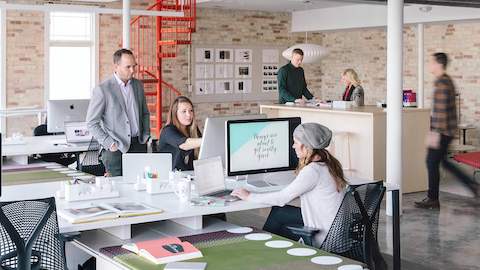Concept A
Creative vision and some interior design help gave Concept A an office that works for them
Spring Lake, Michigan, US
Download PDF (2.3 MB)
It’s tempting for small business owners to draw upon their DIY ethos for just about everything, from HR to SEO. However, bringing in the expertise of outside professionals often makes good business sense—especially in those areas where inexperience could result in costly miscues.
Creative Director Andrew Dull realized that fact early on in the process of relocating his growing Michigan-based graphic design firm.
Concept A opened its doors in 2008 in a 1,000-squarefoot storefront in Grand Haven, Michigan. Dull hired his first employee within two months of setting up shop—which, at the time, consisted of little more than a couple tables and his MacBook Pro.
The studio grew by an average of one employee per year through its first five years, and, by 2012, the modest space could no longer adapt. “It quickly became clear that 1,000 square feet maxed out at five people,” Dull said. “We were on top of one another. We overheard every conversation. We only had a single, shared bathroom. It just became problematic.”
The close quarters were only part of the issue. Dull also wanted Concept A’s space to provide a better experience for current employees, potential new hires, and prospective clients.
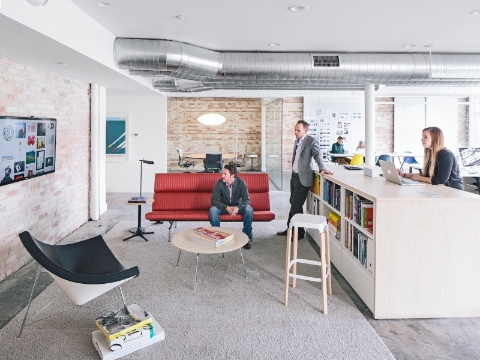
Timeless classics from the Herman Miller Collection, such as the Eames Sofa Compact and Nelson Coconut Chair, lend a relaxed, residential feel to Concept A's space, creating the perfect Cove where employees can or meet casually, retreat, or just unwind.
“Your space and your furniture can do a lot for your brand perception,” Dull said. “That impacts everything from recruiting and business development to employee satisfaction and retention. So we needed to find and furnish a space that could support what we are today and sustain us as we continue to grow.”
When Dull began looking for new office space, it took every bit of his creative vision to recognize the potential of a 100-year-old commercial building in downtown Spring Lake, a resort town just down the Lake Michigan shoreline from Concept A’s original location.
The building, which at different points in its history had housed an undertaker, a hardware store, and a surf/skateboard shop, had been vacant for seven years. It was in such disrepair that state inspectors had deemed it “blight.”
Undaunted, Dull took on the reclamation project with the help of Rick Edwards, a design consultant with Herman Miller. Edwards studied how Dull’s employees used their Grand Haven office: how they worked together, how they sought privacy, how they stored paper, how they conducted meetings. He also met with employees to discuss their ideas for the new space. Edwards’ observations uncovered needs Dull hadn’t considered.
“At first, I just didn’t feel like (an employee lounge) was the best use of our square footage,” Dull said. “But working with Rick convinced me that providing a comfortable, almost residential feel is extremely important for our employees. In the final design, it became a real asset of the space.”
To extend a more comfortable experience of work beyond the lounge area, Edwards’ design for the space offers a variety of settings, all optimized to support different types of work and interaction. This approach to space design empowers people to choose the setting that best meets the needs of the task at hand. At Herman Miller, we call this approach Living Office.
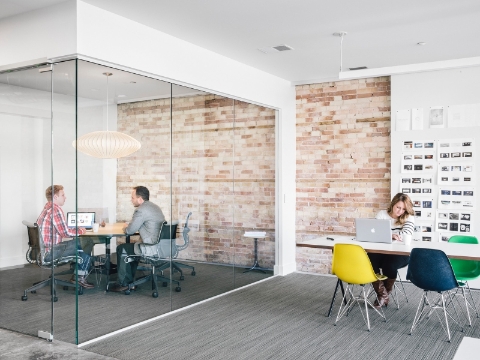
Concept A’s Meeting Space allows designers to meet with clients in a comfortable, quiet space outfitted with Setu chairs and appropriate technology.
Concept A’s Living Office is comprised of four distinct settings: a Clubhouse, a Cove, a Meeting Space, and two Workshops.
Set apart from the main-level Clubhouse, where employees perform their heads-down, focused work, Concept A’s lounge, or Cove, gives people a place to go to peruse design books for inspiration, or just to relax. Concept A’s original office space lacked a formal Meeting Space, which made this setting crucial for the new location. The balance of the new, 2,700-square-foot space is dedicated to two Workshop areas: a second-floor space that doubles as an art and photography studio, and a space on the main level that supports idea generation, research, and production work.
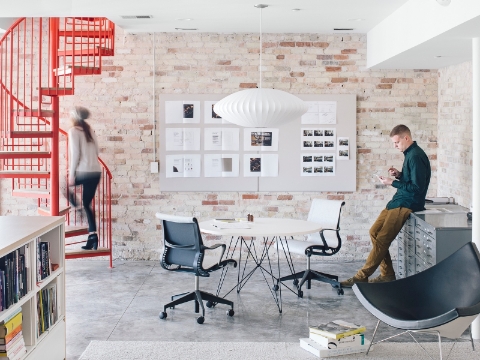
A main-level Workshop area provides comfortable seating and plenty of room for idea generation, research, and production. Concept A designers use the upstairs for for photography or art-making.
The renovation project took a full year to complete, and, late in 2013, Concept A moved in. The collaboration with Edwards and Herman Miller yielded a sophisticated, contemporary space that intuitively supports the firm’s work flow while communicating the life and vitality of the studio to visitors. In the end, Dull enjoyed the design process as much as his employees have enjoyed the results.
“For me, as a creative director, partnering with an architect and interior designer wasn’t all that different from partnering with illustrators or photographers in the work we do every day for our clients,” he said. “It was a huge design problem to solve, but we were able to assemble a team with the right skills to execute our vision. It was kind of fun to see a building that was sort of an eyesore turn into something beautiful and purposeful.”
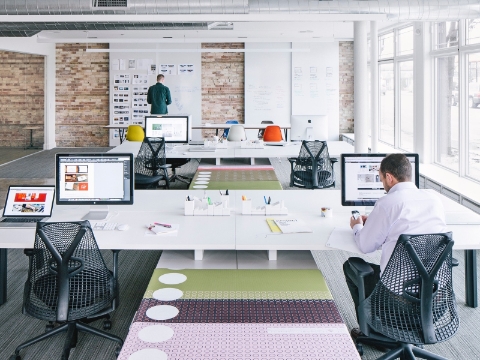
Primary employee workspaces are furnished with Sayl performance seating. An adjacent collaborative space features reconfigurable work tables and movable marker boards. This Clubhouse setting can support employees as they co-create or divide and conquer.
